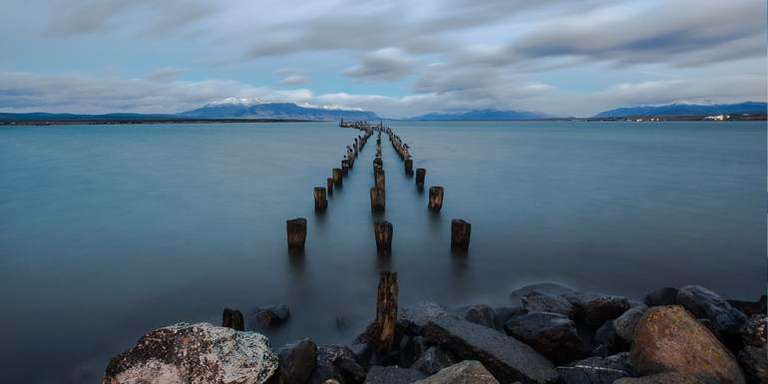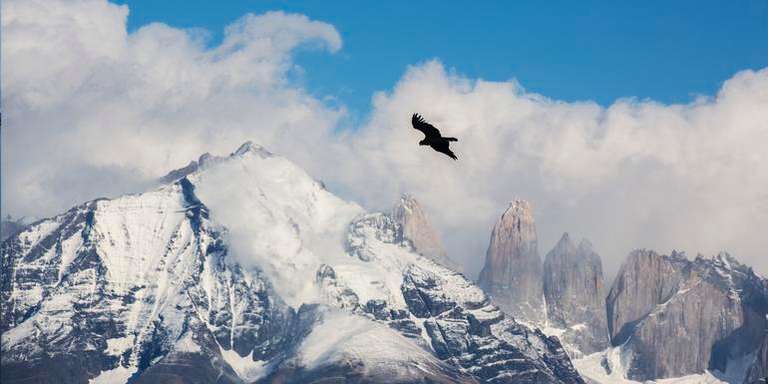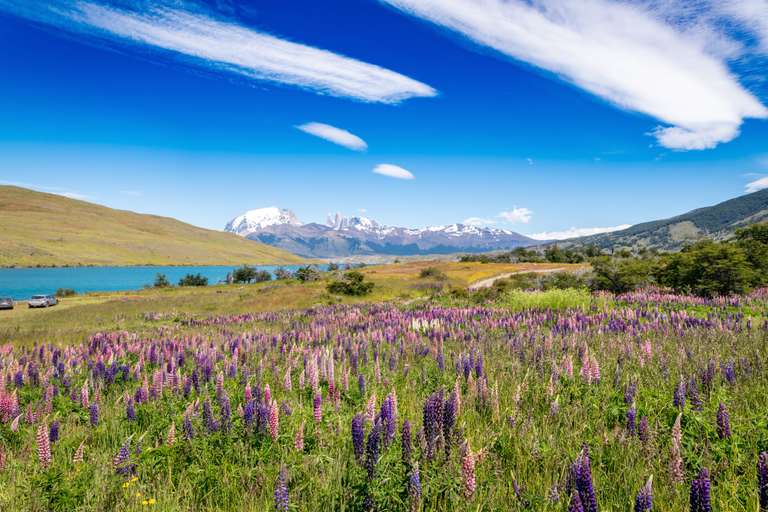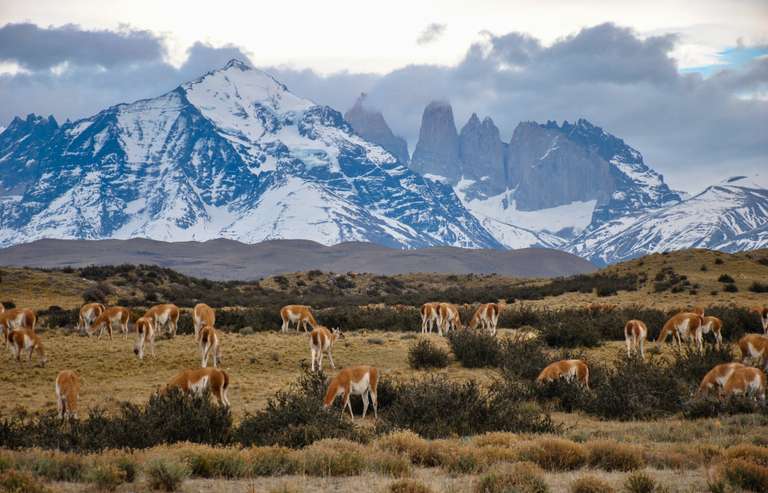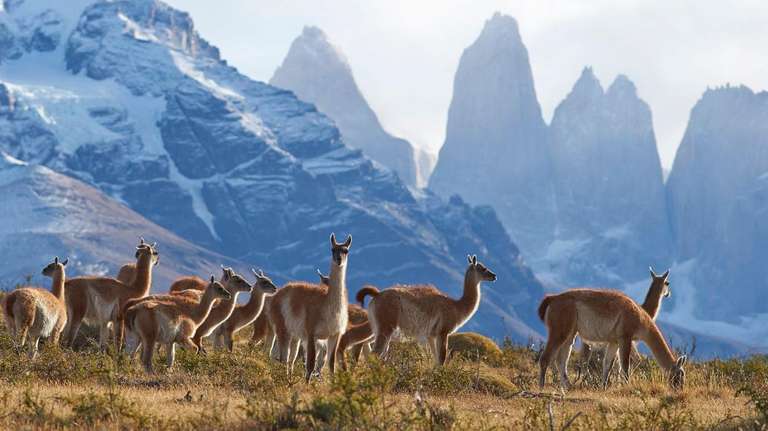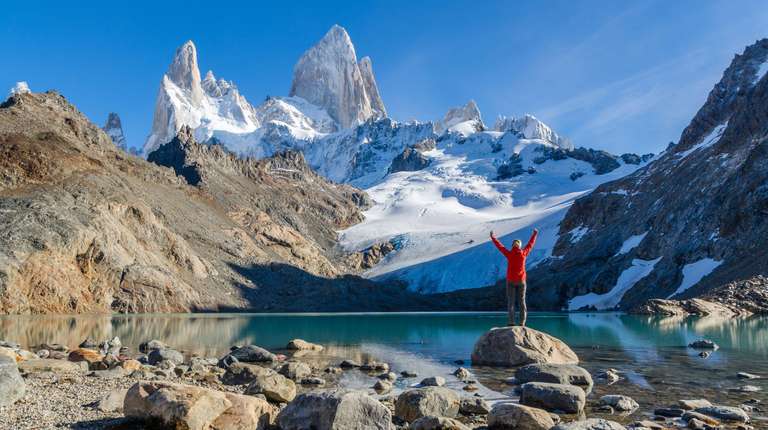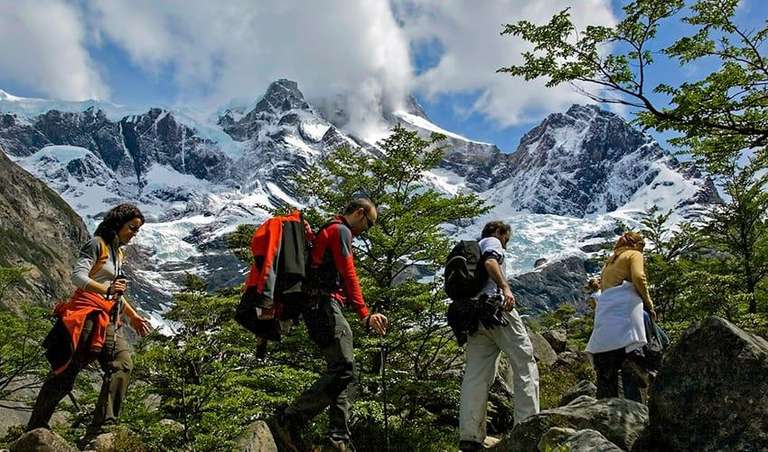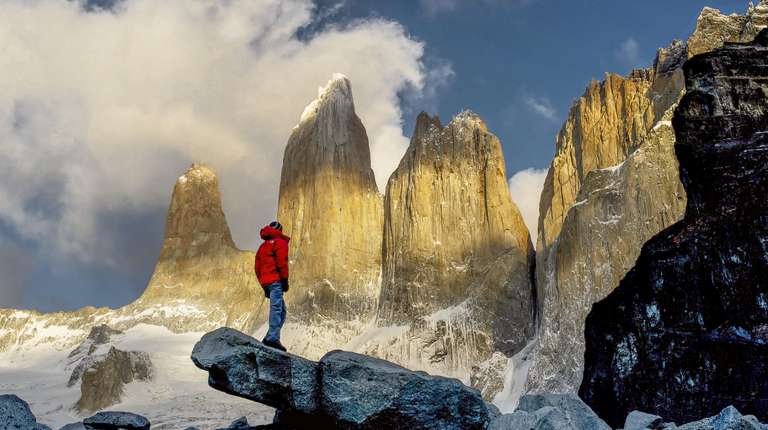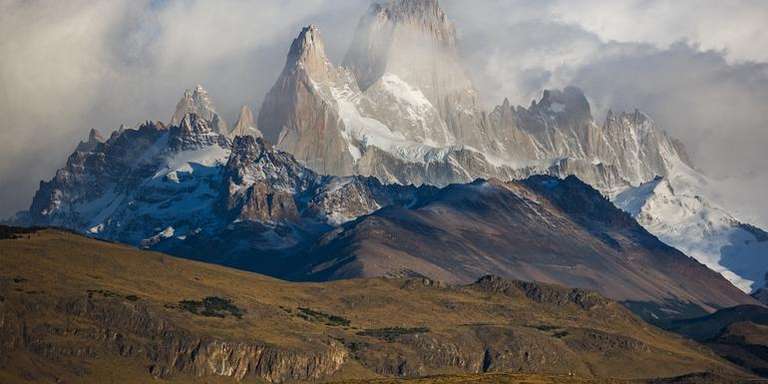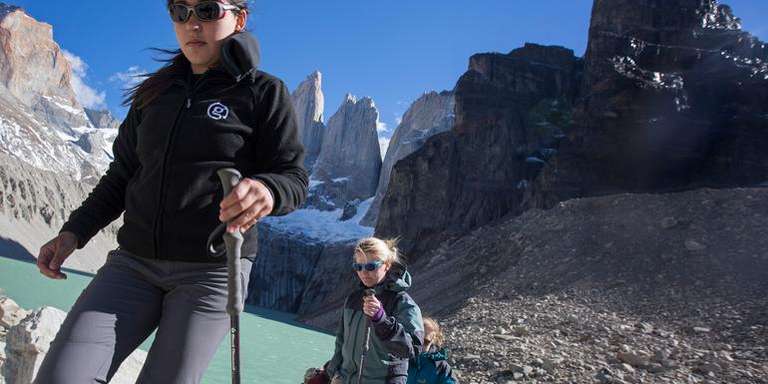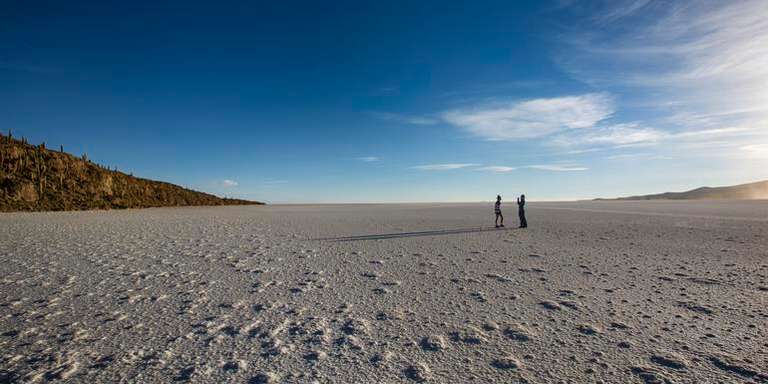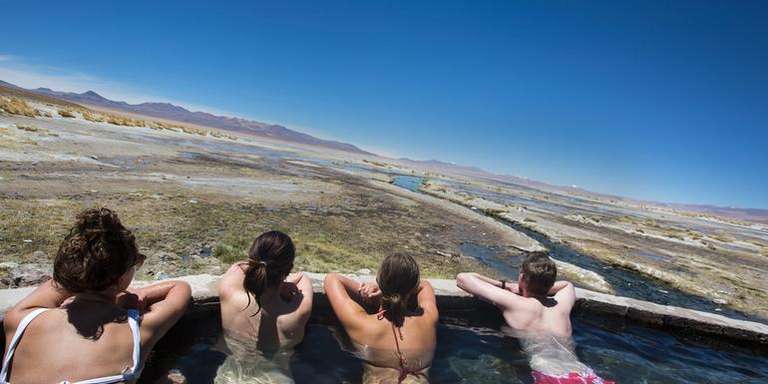9 Best Treks and Hikes in Patagonia

- Kimberly G
- From
- Kimberly G
- From
- Maria A
- From
- Stephanie Z.
- From
1. Villa O’Higgins to El Chaltén Trek

Embark on a wilderness journey through the heart of Patagonia on the trek from Villa O’Higgins (Chile) to El Chaltén (Argentina). This adventure will take you to some of the planet's most remote landscapes. Beginning with a boat ride across Lago O’Higgins, where the majestic O’Higgins Glacier awaits, the trek winds through forests and across borders, eventually leading to the iconic Lake Fitzroy. Along the way, you will either camp or stay in guest houses at places like El Mosco and Candelario Mansilla surrounded by stunning scenery.
Highlights:
- Witness the raw power and beauty of the O’Higgins Glacier, one of the largest in Patagonia, during a boat journey across Lago O’Higgins..
- Experience the unique opportunity of crossing borders on foot, transitioning from Chilean wilderness into the stunning landscapes of Argentina.
- Encounter the mesmerizing beauty of Lake Fitzroy and the iconic Mount Fitzroy, whose rugged peaks and dramatic landscapes are among the top highlights of the trek.
- Enjoy the thrill of spending nights in some of the most remote locations in the world, such as El Mosco and Candelario Mancilla.
Trek Facts
| Trek difficulty | Fairly demanding |
| Trek duration | 2 days for 130 kilometers |
| Maximum altitude | Around 700 meters |
| Accomodation type | Lodge and/or camping |
| Best season | November to April |
| Permits required | None. However, you need to get your passport stamped at border posts during the trek. |
| Physical fitness level required | Good |
2. The Huemul Circuit Trek

The Huemul Circuit in Parque Nacional Los Glaciares of Argentine Patagonia is one of the most scenic and by far most difficult treks you’ll come across. Stunning glaciers, lakes and mountain tops will take your breath away. However, you’ll climb up steep slopes and slide down even steeper slopes, as well as rappel yourself across rivers. You’ll find that the difficulty puts many people off, so if you enjoy not meeting too many other trekkers, now you know why. Seeing the sunrise by a glacial lake as icebergs float by, or enjoying a starry sky by yourself at night will be memories that last a lifetime.
Highlights:
- Experience breathtaking vistas of jagged peaks, glaciers, and lakes showcasing the stunning beauty of Patagonia, including the iconic landmarks such as Cerro Huemul and the Southern Patagonian Ice Field.
- Experience the thrill of crossing glaciers as you navigate through the challenging terrain of the Southern Patagonian Ice Field.
- Encounter a diverse array of wildlife along the route, including guanacos, foxes, and condors.
- Camp in remote and scenic locations surrounded by the beauty of the Patagonian wilderness.
Trek Facts
| Trek difficulty | Very demanding |
| Trek duration | 4 days |
| Maximum altitude | Approximately 1550 meters |
| Accommodation type | Camping |
| Best season | October to April |
| Permits required | No, but there is an entry fee to Parque Nacional Los Glaciares. You also need to register your details so that the authorities can send a search and rescue party in case of any untoward event. |
| Physical fitness level required | Very good |

Immerse yourself in the awe-inspiring beauty of Mount Fitz Roy, its towering granite peak dominating the skyline with a jagged silhouette, as you embark on your unforgettable hike.
When talking about hiking in Patagonia, one cannot overlook the iconic Mount Fitz Roy hike. This captivating hike offers breathtaking views of Mount Fitz Roy and other iconic peaks like Cerro Torre and Cerro Fitz Roy, reflected in the turquoise waters of Laguna Capri and Laguna de los Tres. As you traverse the ancient forests, you can also encounter the roaring Chorrillo del Salto waterfall. The journey typically starts and ends in the charming town of El Chalten, which serves as a hub for trekkers exploring the region.
Highlights:
- Experience the awe-inspiring beauty of Mount Fitz Roy, a towering granite peak that dominates the skyline with its jagged silhouette.
- Witness the breathtaking view of Mount Fitz Roy reflecting on the turquoise waters of Laguna de los Tres.
- Traverse the picturesque trail of Los Glaciares National Park that winds through ancient forests, glacier streams, and alpine meadows.
- The Mount Fitz Roy base is a stunning sight with its various peaks sticking up into the sky.
- The bright blue lagoon, Laguna de los Tres and its famed beauty will greet you.
- If you go to the small hill to the left of Laguna de los Tres, you’ll be able to see Laguna Sucia too.
Hike Facts
| Hike difficulty | Fairly demanding |
| Hike duration | 2 to 3 days |
| Maximum altitude | 3,405 meters |
| Accomodation type | Camping |
| Best season | November to March |
| Permits required | Yes |
| Physical fitness level required | Moderate |
4. Torres del Paine National Park 'W' Trek

The ‘W’ Trek in Torres del National Park is one of the most popular hiking trails in Patagonia. This renowned route offers a perfect balance of challenging hike and rewarding scenery, allowing adventurers to immerse themselves in the pristine beauty of one of Chile’s most cherished natural wonders. Whether marveling at the iconic Torres peaks, navigating the famous French Valley, or encountering wildlife, the ‘W’ Trek promises an unforgettable journey through the heart of Patagonia’s wilderness.
Highlights:
- Witness the awe-inspiring beauty of the iconic granite towers of Torres del Paine.
- See the stunning Glacier Grey, where massive icebergs calve off into the milky blue waters of Lago Grey.
- Hike to the base of the Torres del Paine towers and be rewarded with breathtaking views of these towering granite spires reflected in a glacial lake.
- Encounter a diverse array of wildlife, including guanacos, foxes, condors and possibly even the elusive puma, to your Patagonia hiking trip.
Trek Facts
| Trek difficulty | Very demanding |
| Trek duration | 4 to 5 days |
| Maximum altitude | Around 900 meters |
| Accommodation type | Camping or refugios (mountain huts) |
| Best season | November to March |
| Permits required | Yes. It costs around USD35 to enter the park |
| Physcial fitness level required | Very good |
For itineraries, maps and other detailed information, read on to Cerro Castillo Trek.
5. Torres del Paine Circuit Trek

For those seeking a longer and more challenging trek in Torres del Paine National Park, the Circuit Trek is a fantastic option. It takes around 7 to 9 days to complete and covers a wider area of the park, including the famous ‘W’ Trek. With each step, the Circuit Trek reveals new wonders, from the iconic Torres del paine peaks to the remote reaches of the Southern Patagonian Ice Field. This multi-day odyssey promises an unforgettable adventure for those willing to embrace the challenge and discover the true essence of Patagonia’s wild allure.
Highlights:
- Navigate through the challenging mountain passes, such as the John Gardner Pass, where you will be rewarded with panoramic views of glaciers and snow-capped peaks.
- Encounter the iconic sights of the peak, including the towering granite spurs of the Torres del Paine, which glow with fiery hues during sunrise and sunset.
- Explore the pristine wilderness of the park, where guanacos roam freely, condors soar overhead, and the thunderous roar of glacial rivers fills the air.
Trek Facts
| Trek difficulty | Very demanding |
| Trek duration | 7 to 9 days |
| Maximum altitude | Around 1,180 meters |
| Accommodation type | Camping or refugios (mountain huts) |
| Best season | November to March |
| Permits required | Yes. The permit costs around USD 55. |
| Physical fitness level required | High |
6. Perito Moreno Glacier hike

This iconic trail promises a fusion of breathtaking panoramas and exhilarating wildlife encounters. See the majestic Andean condors soar overhead and elusive Patagonian foxes dart through the landscape. En route, you can also explore nearby attractions such as Perito Moreno National Park and the charming town of El Calafate. If you are on a Patagonia trip, Perito Moreno Glacier hike is a once-in-a-lifetime experience not to be missed.
Highlights:
- Marvel at the towering ice walls and frozen expanse of Perito Moreno Glacier.
- Embark on a thrilling ice trekking adventure on a guided tour to Patagonia, exploring the glacier’s otherworldly terrain and discovering hidden ice caves.
- Enjoy the panoramic views from the glacier’s surface, including snow-capped mountains, glacial valleys, and the shimmering waters of Lake Argentino.
- Spot unique wildlife species that inhabit the glacier’s surroundings, such as Andean condors, eagles, and occasionally even pumas.
Hike Facts
| Hike difficulty | Less demaning |
| Hike duration | 2 to 6 hours |
| Maximum altitude | Around 300 meters |
| Accommodation type | Day hike from El Calafate town |
| Best season | October to April |
| Permits required | Yes. The permit costs around USD 4. |
| Physical fitness level required | Good |
7. Cerro Torre Trail

Named after the awe-inspiring Cerro Torre, one of the mountains on the Southern Patagonian Ice Field, this trail promises breathtaking sights such as Laguna Torre, where the cerulean waters mirror the dramatic spire above, and the ethereal Piedras Blancas Glacier. The nearby town of El Chalten serves as a getaway to exploration, offering a quaint base camp where travelers can rest and rejuvenate amidst the rugged beauty of Patagonia. With its blend of rugged landscapes and mythical allure, the Cerro Torre trek promises an unforgettable odyssey into the heart of one of the Earth’s last frontiers.
Highlights:
- Explore the mesmerizing beauty of glacial valleys as you make your way towards Laguna Torre. Witness the ethereal serenity of the landscape where turquoise waters mirror the towering spire of Cerro Torre.
- Experience nature's sheer power and beauty as you encounter cascading waterfalls and icy blue glaciers along the trail.
- Camp beneath the star-studded skies, listening to the sounds of frozen wilderness.
Trek Facts
| Trek difficulty | Extremely demanding |
| Trek duration | 4 to 5 days |
| Maximum altitude | Around 1500 meters |
| Accommodation type | Camping |
| Best season | November to March |
| Permits required | Yes. The permit costs around USD13 |
| Physical fitness level required | Excellent |
8. Mount Tronador

With its snow-capped peaks piercing the azure sky, Mount Tronador stands as a towering symbol of Patagonia’s grandeur. On this trek, you will encounter an awe-inspiring spectacle of glacial valleys, cascading waterfalls and towering peaks. As you ascend toward the summit, you will be awe-struck by the beauty of Patagonia. Nearby destinations such as the Black Glacier and the tranquil shores of Lake Mascardi beckon explorers to further immerse themselves in the splendor of this part of Patagonia.
Highlights:
- Venture deep into the heart of the Andes, where hidden waterfalls cascade down sheer cliffs and crystal-clear alpine lakes shimmer in the sunlight. Explore the enchanting beauty of destinations like Los Alerces Waterfall and the tranquil shores of Lake Mascardi.
- Stand in awe at the foot of glaciers, where ancient ice meets the rocky earth with a deafening roar. Witness the raw power of nature as massive ice formations calve into icy blue lagoons.
- Pitch your tent beneath a starlit sky, surrounded by the rugged beauty of the Andean landscape. Fall asleep to the gentle rustle of the wind and awaken to the first light of dawn that paints the mountains in hues of gold and pink.
Hike Facts
| Hike difficulty | Fairly demanding |
| Hike duration | 1 day hike |
| Maximum altitude | Around 3500 meters |
| Accommodation type | Hotels / lodges in towns |
| Best season | November to April |
| Permits required | Yes. The permit costs around USD 5. |
| Physical fitness level required | Good |
9. Dientes De Navarino Trek

Of the many treks and hikes, Dientes de Navarino trek is probably the least heard of and the most difficult one, It is also one of the most unique places to hike in Patagonia. The trail that snakes through the Dientes de Navarino mountain range, which literally translates to Teeth of Navarino because of the jagged pinnacles that look like teeth, allows trekkers to see some of the most spectacular scenery in South America. The incredibly beautiful trek is also grueling, inviting very few challengers.
Highlights:
- Marvel at diverse landscapes, from jagged peaks to pristine lakes, and soak in breathtaking vistas of the Beagle Channel.
- Challenge yourself as you navigate steep ascents, descents and potentially unpredictable weather conditions.
- Keep your senses sharp to catch a glimpse of unique wildlife species such as guanacos, foxes, and the majestic Andean condor.
Trek Facts
| Trek difficulty | Very demanding |
| Trek duration | 4 days |
| Maximum altitude | Around 859 meters |
| Accommodation type | Camping |
| Best season | December and March |
| Permits required | No, but you must register your trekking plans at the local police station for safety reasons. |
| Physical fitness level required | Very good |
Things to Consider when Choosing a Hike or Trek in Patagonia
- Make an honest assessment of your fitness. Remember, the duration and difficulty of a trek or hike and your fitness level go hand in hand.
- Decide if you are prepared to camp out in the wilderness or rather stick to the trekking routes where base camps are available? If you cannot do without comfort, opt for routes with proper lodging facilities.
- Find treks/hikes that are suitable for your level of experience — you’ll find everything from half-day hikes, to week-long treks, and you can, of course, choose to go off the beaten path too.
- Consider your budget. It plays a big role in the length of the trek, and whether you stay in luxurious lodges or basic camps.
- Hiring an experienced guide is highly recommended for some of the treks in Patagonia, so research the route and difficulty level in advance.
Safety Consideration
- Check the best time to visit Patagonia before your trip. Generally, the period between November and March is considered the best time to visit the region.
- Both the terrain and climate of Patagonia are diverse, so be prepared for all kinds of weather events.
- Always carry walking sticks and first aid kits and wear comfortable, waterproof clothing and proper hiking shoes to tackle the unpredictable terrain.
- Inform someone of your whereabouts or where you plan to go.
- Carry maps and GPS devices to navigate your way.
Hiking in Patagonia is an experience unlike any other. It offers the opportunity to explore some of the world's most spectacular and untamed landscapes. From the towering peaks of Mount Fitz Roy to the rugged beauty of the Cerro Castillo Circuit, Patagonia's trails promise unforgettable adventure. So lace up your boots and embark on a journey of a lifetime.
For a more seasonal overview, check out our guide on the best time to visit Patagonia. Our article on things to do in Patagonia will also come in handy.


